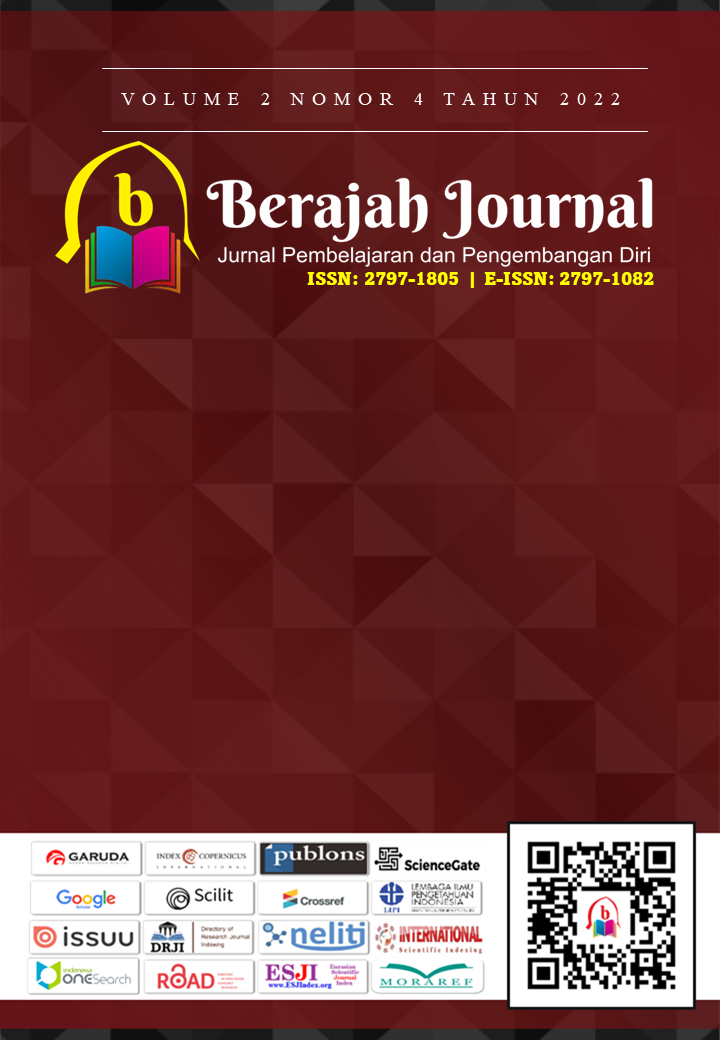PERSEPSI SISWA TERHADAP BLENDED LEARNING
DOI:
https://doi.org/10.47353/bj.v2i4.186Keywords:
persepsi siswa, blended learning, delone & mcleanAbstract
Blended learning merupakan pendekatan pembelajaran terintegrasi yang mengombinasikan efektivitas pembelajaran tatap muka dengan kemudahan dalam mengakses pembelajaran dengan memanfaatkan teknologi informasi. Penelitian ini bertujuan untuk menguji model Delone & McLean yang telah di-update dalam memprediksi faktor-faktor yang mempengaruhi persepsi siswa terhadap manfaat yang diperoleh dari pelaksanaan pembelajaran dengan metode blended learning. Model penelitian ini berdasarkan variabel-variabel kualitas sistem, kualitas informasi, kualitas layanan, penggunaan, kepuasan pengguna, dan manfaat yang dirasakan terhadap blended learning. Data diperoleh dari survei dengan 208 responden siswa SMA Negeri 8 Kota Jambi, dan kemudian data dianalisis menggunakan software SPSS untuk pengujian model penelitian dan pengujian hipotesis. Didapatkan hasil signifikan pada manfaat yang dirasakan siswa terhadap blended learning. Penggunaan model Delone & McLean memberikan acuan praktis bagi penyelenggara pendidikan untuk terlibat secara aktif dalam penggunaan media pembelajaran yang memaksimalkan pemanfaatan teknologi informasi.
Downloads
References
Allen, B., Crosky, A., McAlpine, I., Hoffman, M. E., & Munroe, P. (2009). A blended approach to collaborative learning : making large group teaching more student-centred. Undefined.
Alqahtani, A. Y., & Rajkhan, A. A. (2020). E-learning critical success factors during the covid-19 pandemic: A comprehensive analysis of e-learning managerial perspectives. Education Sciences, 10(9), 1–16. https://doi.org/10.3390/educsci10090216
ANNISA SRI WAHYUNI, -. (2022). EVALUASI KEBERHASILAN PENERAPAN E-LEARNING UIN SUSKA RIAU MENGGUNAKAN MODEL DELONE DAN MCLEAN DENGAN PENDEKATAN STRUCTURAL EQUATION MODELLING (SEM).
Chaeruman, U. A., Wibawa, B., & Syahrial, Z. (2018). Determining the Appropriate Blend of Blended Learning: A Formative Research in the Context of Spada-Indonesia. American Journal of Educational Research, Vol. 6, 2018, Pages 188-195, 6(3), 188–195. https://doi.org/10.12691/EDUCATION-6-3-5
Cidral, W. A., Oliveira, T., di Felice, M., & Aparicio, M. (2018). E-learning success determinants: Brazilian empirical study. Computers & Education, 122, 273–290. https://doi.org/10.1016/J.COMPEDU.2017.12.001
DAKHI, O., JAMA, J., IRFAN, D., AMBIYAR, & ISHAK. (2020). BLENDED LEARNING: A 21ST CENTURY LEARNING MODEL AT COLLEGE. INTERNATIONAL JOURNAL OF MULTI SCIENCE, 1(08), 50–65. https://multisciencejournal.com/index.php/ijm/article/view/92
DALLE, J., HASTUTI, D., Mahmud, M., PRASETIA, I., & Baharuddin, B. (2020). DeLone and McLean Model Evaluation of Information System Success: A Case Study of Master Program of Civil Engineering Universitas Lambung Mangkurat.
Haeruman, L. D., Wijayanti, D. A., & Meidianingsih, Q. (2021). Efektivitas Blended Learning Berbasis LMS dalam Pembelajaran Matematika. JURNAL RISET PEMBELAJARAN MATEMATIKA SEKOLAH, 5(1), 80–84. https://doi.org/10.21009/JRPMS.051.10
Hasnine, M. N., Ahmed, M. M. H., & Ueda, H. (2021). A Model for Fostering Learning Interaction in Hybrid Classroom based on Constructivism Theory. Proceedings - 2021 10th International Congress on Advanced Applied Informatics, IIAI-AAI 2021, 192–195. https://doi.org/10.1109/IIAI-AAI53430.2021.00034
Hrastinski, S. (2019). What Do We Mean by Blended Learning? TechTrends 2019 63:5, 63(5), 564–569. https://doi.org/10.1007/S11528-019-00375-5
Jayusman, I., Agus, O., & Shavab, K. (2020). AKTIVITAS BELAJAR MAHASISWA DENGAN MENGGUNAKAN MEDIA PEMBELAJARAN LEARNING MANAGEMENT SYSTEM (LMS) BERBASIS EDMODO DALAM PEMBELAJARAN SEJARAH. Jurnal Artefak, 7(1), 13–20. https://doi.org/10.25157/JA.V7I1.3180
Malaeb-Khaddage, F., Malaeb-Khaddage, F., & Crompton, H. (2018). Building Teacher Capacity for Blended Learning Environments. Society for Information Technology & Teacher Education International Conference, 2018(1), 1039–1044. https://www-learntechlib-org.cupdx.idm.oclc.org/p/182811/
Marlina, E. (2020). Pengembangan Model Pembelajaran Blended Learning Berbantuan Aplikasi Sevima Edlink. Jurnal Padegogik, 3(2), 104–110. https://doi.org/10.35974/jpd.v3i2.2339
Ohliati, J., & Abbas, B. S. (2019). Measuring Students Satisfaction in Using Learning Management System. International Journal of Emerging Technologies in Learning (IJET), 14(04), 180–189. https://doi.org/10.3991/IJET.V14I04.9427
Ojo, A. I. (2017). Validation of the DeLone and McLean Information Systems Success Model. Healthcare Informatics Research, 23(1), 60. https://doi.org/10.4258/HIR.2017.23.1.60
Sabeh, H. N., Husin, M. H., Kee, D. M. H., Baharudin, A. S., & Abdullah, R. (2021a). A Systematic Review of the DeLone and McLean Model of Information Systems Success in an E-Learning Context (2010-2020). IEEE Access, 9, 81210–81235. https://doi.org/10.1109/ACCESS.2021.3084815
Sabeh, H. N., Husin, M. H., Kee, D. M. H., Baharudin, A. S., & Abdullah, R. (2021b). A Systematic Review of the DeLone and McLean Model of Information Systems Success in an E-Learning Context (2010-2020). IEEE Access, 9, 81210–81235. https://doi.org/10.1109/ACCESS.2021.3084815
Urbach, N., & Müller, B. (2012). The Updated DeLone and McLean Model of Information Systems Success. 1–18. https://doi.org/10.1007/978-1-4419-6108-2_1
Yakubu, M. N., & Dasuki, S. I. (2018). Assessing eLearning systems success in Nigeria: an application of the DeLone and McLean Information Systems Success Model. Journal of Information Technology Education: Research, 17, 183–203. https://doi.org/10.28945/4077
Zhang, Z., Cao, T., Shu, J., & Liu, H. (2020). Identifying key factors affecting college students’ adoption of the e-learning system in mandatory blended learning environments. Https://Doi.Org/10.1080/10494820.2020.1723113. https://doi.org/10.1080/10494820.2020.1723113
Downloads
Published
How to Cite
Issue
Section
License
Copyright (c) 2022 Suroto, Elvi Yanti

This work is licensed under a Creative Commons Attribution 4.0 International License.




















